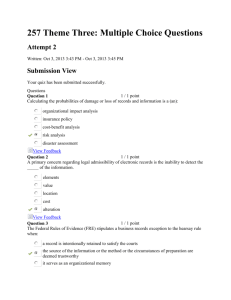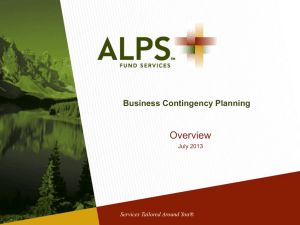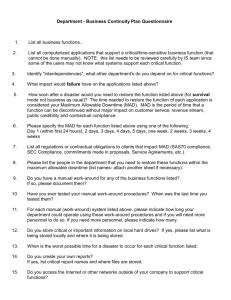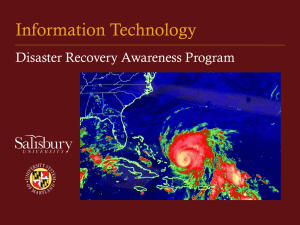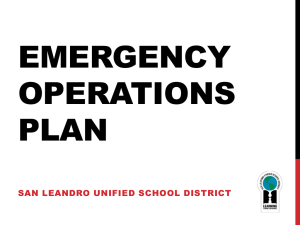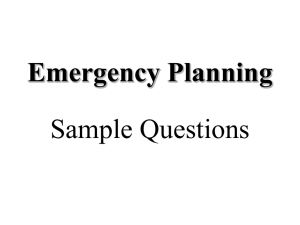The Information Manager`s Role in Disaster
advertisement
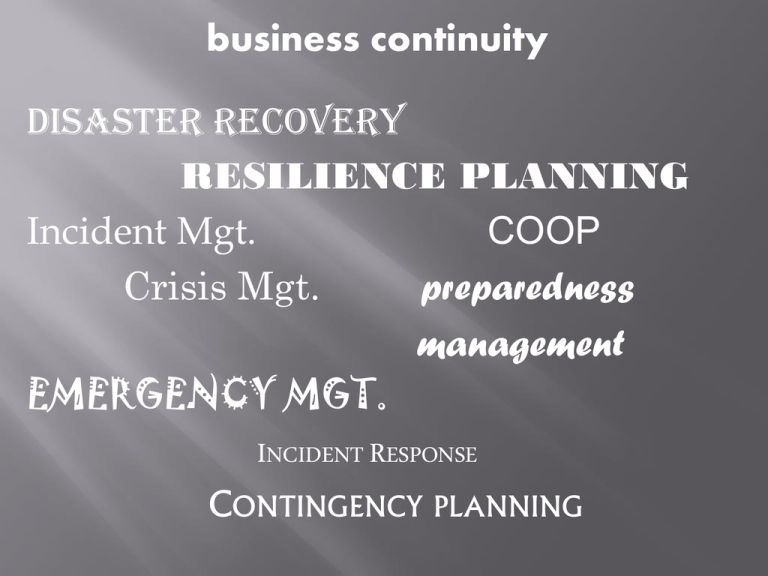
business continuity Disaster Recovery RESILIENCE PLANNING Incident Mgt. COOP Crisis Mgt. preparedness management EMERGENCY MGT. INCIDENT RESPONSE CONTINGENCY PLANNING KNOW YOUR ROLE IN CONTINGENCY PLANNING / DISASTER RECOVERY AZ ARMA CHAPTER April 19, 2012 Monique Hafler Katherine Jonelis 1. Overview of BCP 2. Contingency Planning/BCP 3. Recovery Planning 4. Business Impact Analysis (BIA) 5. Vital Records Protection Disaster Recovery OR Business Continuity? Phases Contingency Planning – Strategy to minimize the effect of disturbances and to allow for timely resumption of activities for an organization. Often combines several different subplans providing detailed instructions regarding how to conduct the company in the face of several different emergency situations. Contingency Planning – Focuses on continuing operations in the face of some sort of natural disaster, man-made, security violation, intentional or accidental disruption that affects normal operations. Examples from SCF Arizona and Central AZ Project Disaster Sudden, unplanned calamitous event Makes it impossible to perform functions for some period of time Disaster Types: Class 1 – Most severe Class 2 – Local/regional affect Class 3 – Major destruction during work Class 4 – Class 5 – Class 6 – Class 7 – hours Destruction off hours 1 or 2 functions affected Sub function affected Lost document Disaster Recovery Planning Advance planning & preparation Minimize loss Ensure continuity of critical business functions Recovery – “When the smoke clears and the waters recede” Recovery Checklist Annually – Confirm vendor agreements Benefit of a RIM and Retention program Business Impact Analysis (BIA) Business Impact Analysis (BIA) Evaluate critical operations for the organization and determine resources needed to run them. Basis for management to make strategic decisions about recovery. Crucial to know exactly where all critical information resides and to plan for its recovery should the need arise. Business Impact Analysis (BIA) Recovery Time Objective: Period of time within which systems, applications, or functions must be recovered after an outage. Recovery Point Objective: Point in time to which systems and data must be recovered after an outage. Vital Records Protection Program– Ensures continued viability Can resume operations quickly Re-establishes financial and legal status Fulfills obligations ID’s records needed immediately following a disaster 2-8% are Vital Vital Records Protection Program– What does it Include? Start with Inventory Define & Identify Priority After disaster, records needed may not be same as organizational vital records Vital Records Protection Program– Common Vital Records after Disaster: Emergency Plans & Directives Delegation of Authority Building Plans & building system operation manuals Emergency Staffing Assignments Vital Records Protection Program– Protection Methods Fire-resistant safes or cabinets Vaults Duplication Cloud Microfilm or Digital copies Vital Records Protection Program– Electronic Protection Methods Magnetic Back Up Tape Electronic Vaulting Mirroring – Redundancy Hot Site – Warm Site – Cold Site Resources – Records Emergency Planning and Response Webinar – FEMA, www.firstrespondertraining.gov Association of Contingency Planners – AZ Chapter, www.azacp.org Disaster Resource Guide, www.disaster-resource.com NFPA 232, Standard for the Protection of Records – NFPA, www.nfpa.org Vital Records & Business Continuity – ARMA, www.ARMA.org, Online courses BCP Seminar - AIIM, March 2003 Presentations, http://www.aiim.org/Chapters/ChapterWebArticle.aspx? ChapterID=20&WebArticleID=26308 Contact Information: Monique Hafler, Central AZ Project 623-869-2147 mhafler@cap-az.com Katherine Jonelis, SCF Arizona 602-631-2128 kjonelis@scfaz.com
